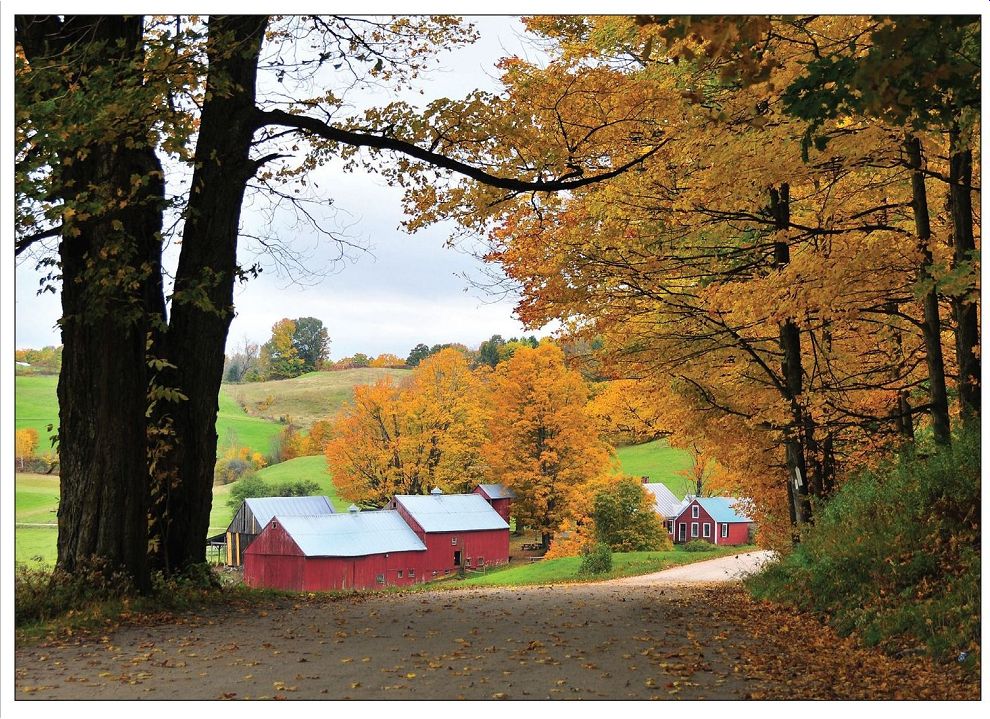
Reaching Downward To Tap the Reservoirs Beneath Our Feet
Water is one of the elementary staples of life, and the existence of a dependable supply of drinking water is probably the single most important factor in determining whether a home site will be livable or not. Virtually all the water we use arrives as rain and collects either on the surface of the ground or beneath it. Most of the privately owned residential water supply in the United States comes from wells. Aboveground sources, such as ponds, lakes, reservoirs, and rivers, supply the remainder, almost always for large-scale users, such as heavy industry and population concentrations in urban and suburban areas.
Digging for water is a centuries-old practice with significant sanitary benefits. Due to natural filtration, well water is relatively pure, whereas water in ponds and streams is highly susceptible to bacterial pollution from human and animal waste. But digging wells manually is hard, sweaty work and at depths greater than 10 to 20 feet can be extremely dangerous as well.
Modern methods of well construction, which rely on boring and driving equipment, water pumps, and drilling machinery, avoid most of the danger but still take time, work, and money. In addition, they remain almost as chancy as ever when it comes to striking water. Old-time dowsers and water witches-people who seem to have a special knack for locating subsurface water-are still consulted, but recourse to common sense, a knowledge of local geology, and a professional well digger's experience are likely to prove better guides. Assistance in finding and developing a well on your property can also be obtained from your state's water resources agency.
Where to Find Water
Of the rain that falls on the land areas of the world, the major part collects in lakes and rivers, some evaporates, and the rest, called groundwater, filters slowly into the earth.
In many areas groundwater is the most dependable water--often the only water-available.
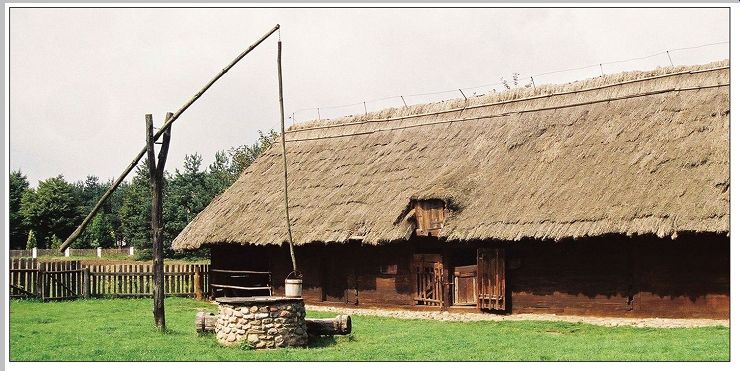
------------------ Old wells were dug with a pick and shovel. When the
water table was near the surface and the well shallow , a long counter-weighted
pole with a bucket at one end sufficed to lift the water up. For deeper wells
(they were sometimes dug down 100 ft.), a windlass was used to crank up each
bucketful of water. When not in use, such wells should be covered as a safety
measure and to keep out dirt and debris.
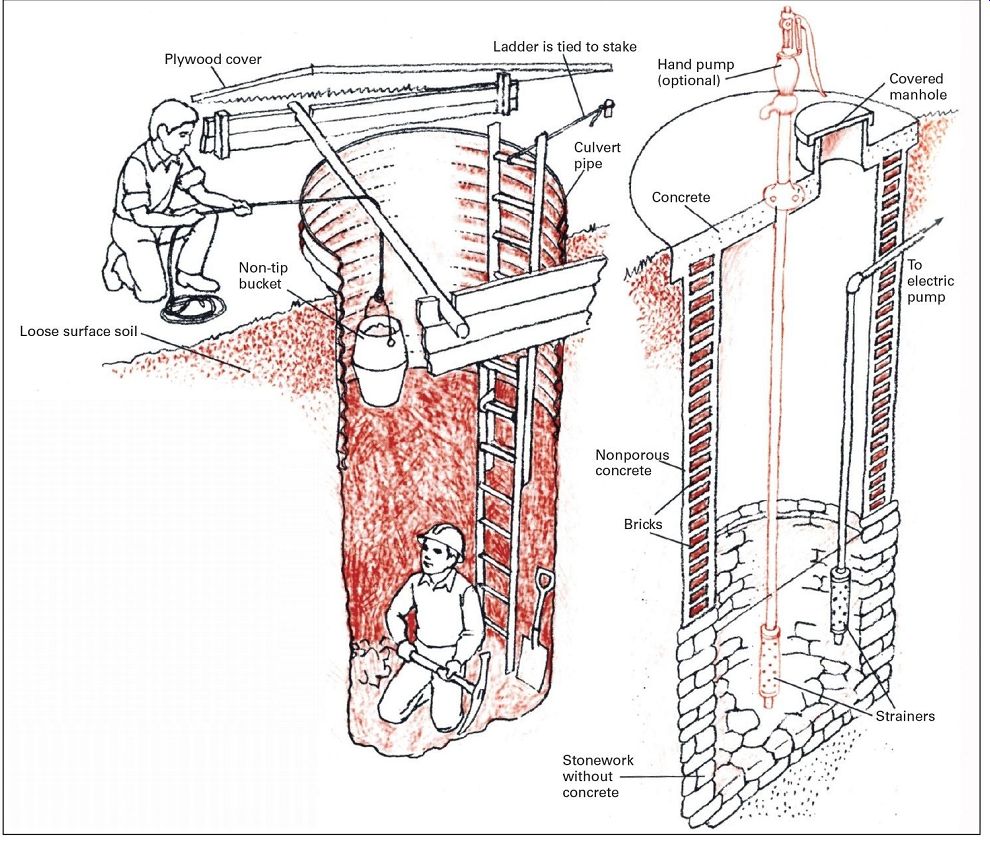
----------------- Digging a well the old-fashioned way is dangerous work
because of the risk of cave-ins; it should never be attempted by an amateur.
A typical old-style well-digging operation is shown at right. The well is 3
1/2 ft. in diameter--wide enough for one man to work. A 4-ft. length of 42
in.-diameter steel culvert pipe has been installed at top to keep loose surface
soil from crumbling into the well. The pipe extends 6 in. above ground level
to prevent supplies and tools from being accidentally knocked in. (such shoring
is considered adequate for a 15- to 20-ft.-deep well in an area with firm subsoil.)
The well is dug until water enters faster than it can be bailed out by hand.
The bottom part of the finished well is lined with stones. To prevent pollution,
the upper part is lined with bricks set in nonporous concrete. The cap is also
nonporous concrete.
The top of a groundwater reservoir is known as the water table, a level that moves up and down according to the rate at which water is being taken out and replenished. In some locales the water table is a few feet from the surface-a relief to well drillers; elsewhere, the table is so far down even drilling becomes impractical.
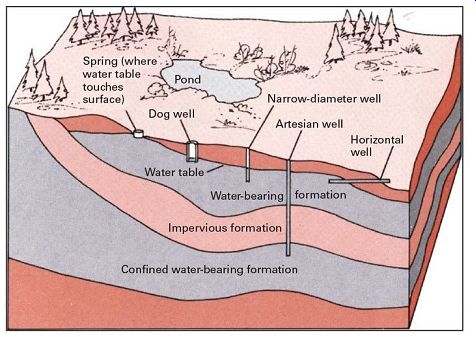
----- Variety of water sources (above) is equaled by the variety of ways water can be tapped. Because of the complex structure of aquifers, wells quite close to each other can nevertheless differ markedly in output.
Groundwater is frequently confined within rock formations, where it forms an aquifer, or underground stream. I f the aquifer originates from a high elevation, the water may be under enough pressure to bubble up spontaneously to the surface when a drill bit reaches it. This type of natural flow is called an artesian well and does not require a pump. Water tables also break the surface, creating seeps, springs, swamps, and ponds.
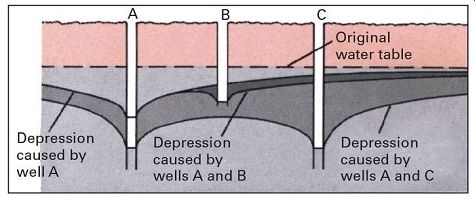
----------- Wells draw the water table down in their vicinity, sometimes causing
neighboring wells to dry up. in the example shown above, well A was dug first,
creating a dry cone-shaped volume around it. Next came well B, which produced
water until well C was put in.
Small-Diameter Well Construction
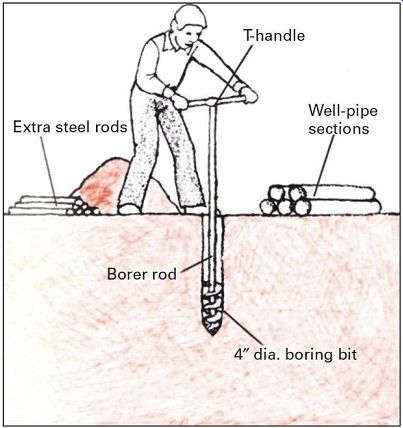
-----------Bored well can be put in with inexpensive hand tools.
First a 1-ft.-deep hole is driven with a pick or crow bar, then the borer introduced. As the borer penetrates, segments are added to its rod to accommodate increased depth.
Periodically, the borer must be lifted to empty the hole of loosened cuttings. Boring is impractical for wells deeper than 50 ft. Moreover, if a large stone or a rock formation is met, the operator has to abandon the hole and start again elsewhere. After water is encountered, the well pipe and water intake are installed.
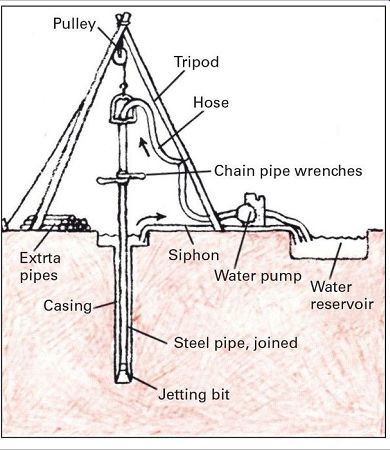
-------- Water-jetted well can be put in fairly rapidly with a pump that
forces water down a pipe. The water pressure jars the soil loose and forces
it up the well hole to the surface. As the well deepens, the pipe should be
rotated periodically to help keep it vertical. The mud in the upward flowing
water helps to line the well wall and prevent crumbling. A casing, installed
as the well is being jetted, will further reinforce the wall. if no rock formation
is encountered along the way, a strong pump can jet a 1-ft.-diameter well to
a depth of 300 ft.
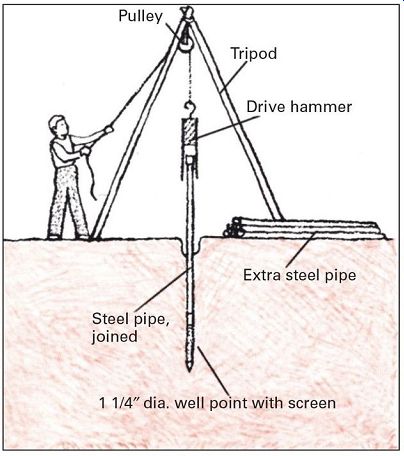
------ Driven well is put in by hammering a pipe directly into the earth.
The point of the pipe is screened to keep dirt out, since it will serve later
as a water intake. The pipe is hammered in by repeatedly dropping a heavy weight
on it.
Well depths of up to 150 ft. can be achieved with equipment like that illustrated. To check for the presence of water, lower a weighted string down the pipe, then raise the string and examine the end to see if it is wet. Once water is detected, drive the pipe down another 20 to 30 ft. to guarantee water supply.
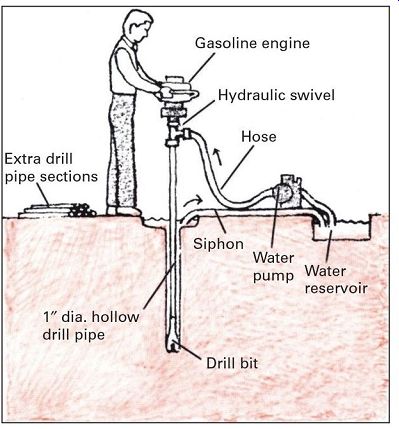
----------- Drilled well can penetrate thousands of feet below the surface;
the depth is limited only by the power of the drilling engine and the quality
of drill bit used. For very hard rock, diamond-tipped bits are required. A
hand-held, 3-horse-power drilling unit like the one shown can reach a depth
of about 200 ft. A water pump is used to wash soil and rock cuttings to the
surface and to cool and lubricate the bit. After the hole is drilled, the hole
is reamed to a diameter of 3 in., and the well pipe and screen (or submersible
pump) are installed.
Aboveground Storage In Pond or Cistern
Of the various types of surface water the most valuable for a home water supply is a spring. Springs can be thought of as naturally occurring artesian wells, the water being pushed to the surface by gravity. A mere trickle can support the water needs of a home if it is collected in a cistern or holding tank. A spring's flow can be measured by timing how long the spring takes to fill a 5-gallon container. For example, if the container takes 30 minutes to fill, the spring will provide 10 gallons an hour, or 240 gallons of water a day-enough to support a small homestead. Remember, however, that springs can run dry at certain times of the year.
In some areas the most practical way to obtain drinking water is to channel rain falling on a roof into gutters that lead into a cistern. In a region of moderate rainfall (30 inches per year), a roof with a surface area of 1,000 square feet will collect an average of 50 gallons of water per day, enough for a two-person household with modest water needs. Since rainfall varies over the year, the cistern must hold enough water to cover expected dry periods. For example, a 50-gallon-per-day requirement could be supported for 30 days by a cistern that is about 6 feet on each side and 5 1/2 feet deep. Cisterns up to five times this size are practicable.
For large-scale water storage a pond is usually the best alternative. Ponds are excellent for such major uses as irrigation, livestock maintenance, and fish farming. In addition, they attract and support wildlife and provide water for fire protection if located within 100 yards or so of the structure to be protected. A pond can be a simple excavated hole if the water table at the site is close to the surface, or an earth embankment can be built to collect runoff. Unless the pond is also intended for power generation (see Waterpower, p.69), you should not attempt to impound a running brook. (There are legal restrictions that govern the development and use of waterways, and, in addition, a large and expensive spillway may have to be constructed.) The probability is high that water from ponds, brooks, and similar aboveground sources will not be healthy enough to drink, particularly if livestock have direct access to the water source or if the source is located in areas suffering from pollution, such as mining regions. If necessary, water can be purified with ceramic filters or by chlorination. In emergencies the water can be boiled.
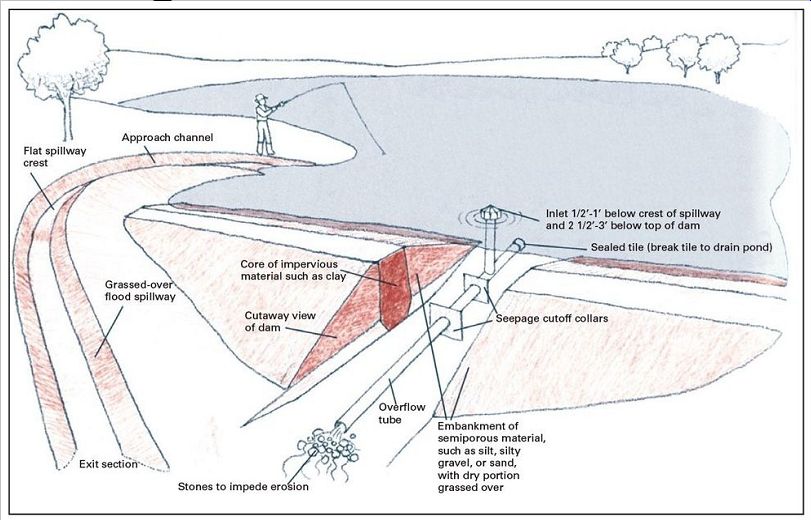
------------ Pond formed by an earth embankment must
have an adequate spillway, preferably excavated from undisturbed soil. The
spillway is only for emergencies. Overflow is generally handled by an overflow
tube built into the dam.
To prevent undermining by water seepage, a core of impervious material should be included in the structure.
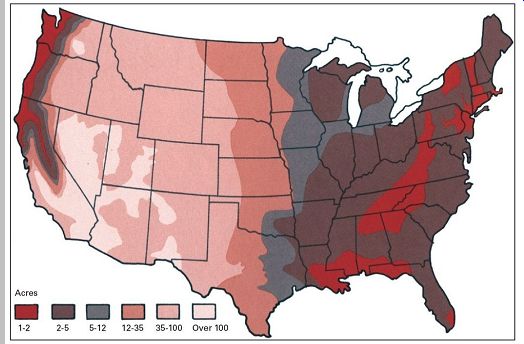
--------------------- Use map to estimate acreage you
will need to maintain a pond of a chosen size in your part of the country.
The map is derived from annual rainfall data and specifies how many acres of
rain-runoff area are required for each acre foot of pond water. For example,
to create a 1/4-acre, 4-ft. deep pond (1 acre-ft.) in eastern Nebraska will
require 12 to 35 acres of runoff area.
Ways to Collect and Store Rainwater and Spring Water
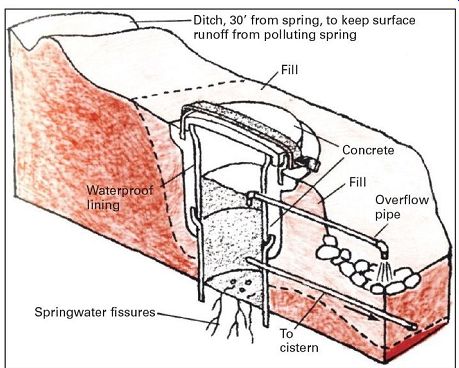
------------- Spring water collection structure, formed
primarily of concrete, helps stabilize water flow and protects water from surface
contamination. Take care when excavating to avoid disturbing the fissures;
otherwise the flow can be deflected.
------ ----- ----
An old-style springhouse
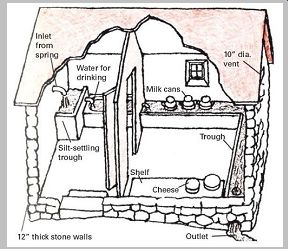
-------- Springhouse of the type built last century put
a spring to work to keep food cool. such perishables as milk and butter were
placed in containers, and the containers were set in a trough through which
cool spring water flowed, keeping the food at refrigerator-like levels even
in summertime.
------- ----- ---
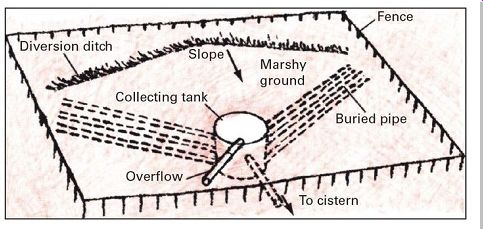
--------- Marshy area can be tapped for water with a system
of perforated or open-joint pipes draining into a tank. Pipes are buried in
packed gravel faced by a plastic barrier on the downslope side to help concentrate
water near them.
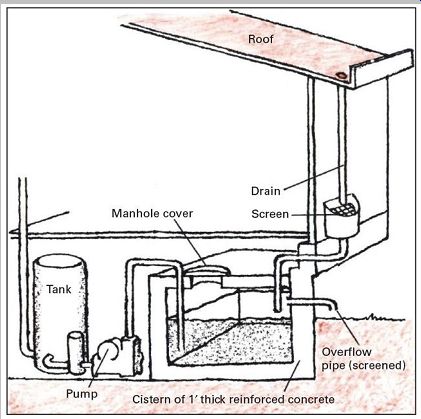
-------------- Typical cistern can hold 180 cu. ft. of
water. since water weighs 62.4 lb. per cubic foot, the cistern and its foundation
must be massive enough to hold 5 to 6 tons of water. The entire system should
be screened and sealed against insects.
------------
---- -----
For pure water
Drinking water should not be considered safe until tested by your county health or sanitation department. These agencies will send an inspector to your property to collect a water sample, then mail you a report on its purity. in particular, be suspicious of water taken from a surface source, even if it comes from a sparkling brook and is clear and odor free.
---------------
==========
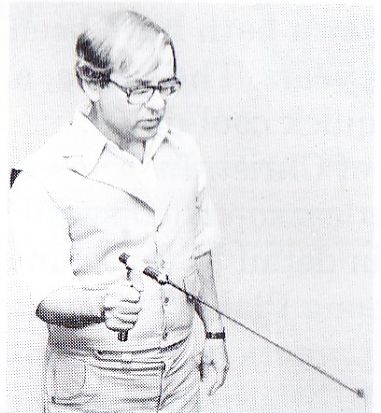
Bill Grande, Jr., Lawyer and Water Witch:
The Secret, Says This Dowser, Is in the Mind, Not the Wand
Bill Grande, Jr., Rhode Island dowser, demonstrates his water witching stance with a wand designed by his former mentor. Bill is involved in treasure hunting, finding minerals, locating underground water supplies and even analyzing personalities.
"Dowsing, it's not just a matter of rod and fork, or anything like that. It really depends on belief, on your own belief. I shouldn’t say anybody could do it. If you don't believe i going to work, it's really not going to work. You know what they say, 'Ya gotta believe!' "Not everybody uses a rod and fork, in fact very few people use them nowadays. The equipment can be just as ingenious as a person can make it. And then, of course, there's professional equipment on the market that you can buy. Most people use pendulums, rods, wands, or even a long, flexible spring. Sometimes the equipment will depend on what kind of thing you're looking for the wands are lighter and more sensitive than heavy metal rods, for example But the equip merit isn't the important thing, in any case. It's just a crutch in a way-having control of your mind is what counts "Of course, not everybody believes in dowsing. Some people are very skeptical, although other people maintain an open mind on the subject. Believe me though, it works. I've found water and minerals and it's not just my say so. I've had some of my finds verified by very respected people in the field. Lately, I have been doing a lot of work analyzing people for honesty, integrity, compatibility, things like that. Dowsers do a lot more than just look for water. I've never done any live work, I mean searching for missing people or things like that.
But, right now, I'm thinking about going down to Florida to do some treasure hunting.
"How do you find things? Well, everything gives off different vibrations, and if you know how to tune into them, you can understand what's going on. Vibrations vary in strength and sonic things are easier to pick up than others. What you find depends on the dowser and the strength of the deposit he is looking for.
"If someone had some property and wanted to locate water, I'd suggest a good, reputable dowser. Believe me, most dowsers are very honest people."
============